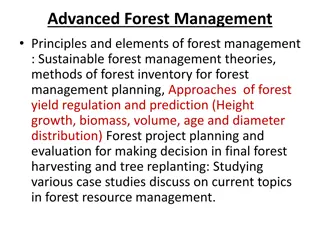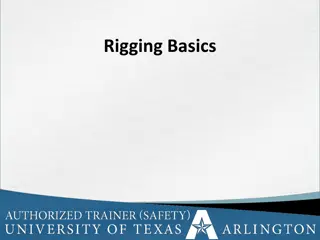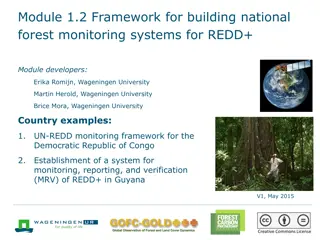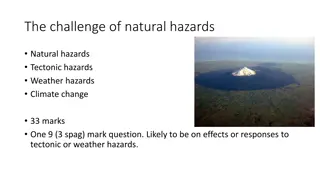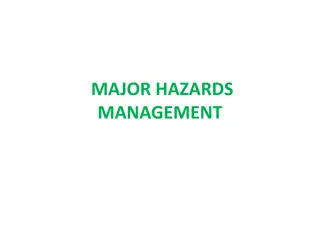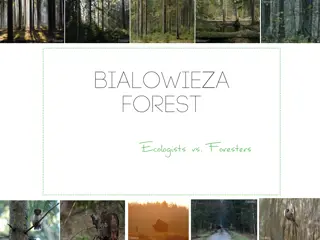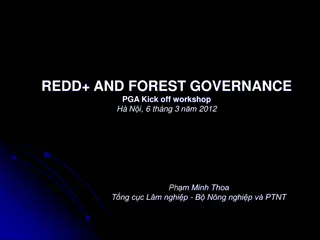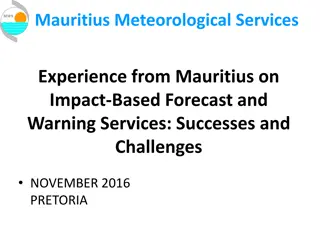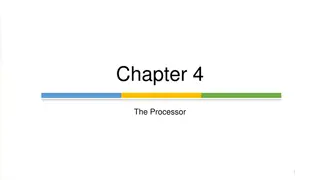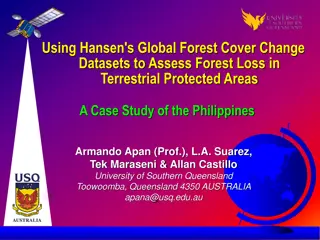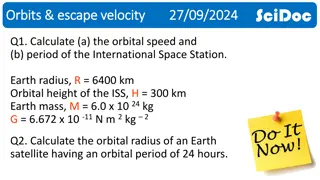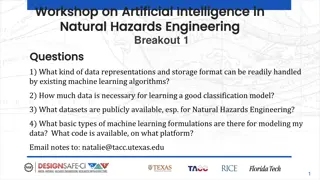Monitoring Forest Cover Disturbances During Natural Hazards by Meteorological Satellites
Ecosystem functioning relies on energy, water, and carbon fluxes regulated by vegetation and soil properties. This study focuses on monitoring forest cover disturbances before, during, and after natural hazards using meteorological satellites. It involves analyzing land surface temperature, evapotranspiration, and fraction of vegetation cover to assess forest health and resilience. Real situations, such as forest fires and tree diseases, are examined in Bulgaria to demonstrate the effectiveness of satellite monitoring in near real-time.
Uploaded on Oct 05, 2024 | 0 Views
Download Presentation

Please find below an Image/Link to download the presentation.
The content on the website is provided AS IS for your information and personal use only. It may not be sold, licensed, or shared on other websites without obtaining consent from the author.If you encounter any issues during the download, it is possible that the publisher has removed the file from their server.
You are allowed to download the files provided on this website for personal or commercial use, subject to the condition that they are used lawfully. All files are the property of their respective owners.
The content on the website is provided AS IS for your information and personal use only. It may not be sold, licensed, or shared on other websites without obtaining consent from the author.
E N D
Presentation Transcript
Monitoring of forest cover disturbances during natural hazards by meteorological satellites SALGEE Julia Stoyanova With contribution of: Christo Georgiev, Andrey Kulishev National Institute of Meteorology and Hydrology, Bulgaria 6th SALGEE Workshop, 14 17 October, Darmstadt, EUMETSAT HQ, Germany MSG Land Surface Applications: Connection of climate and biosphere
Outline Ecosystem functioning is mainly characterized by fluxes and budgets of energy, water and carbon, where vegetation and soil properties regulate the exchange processes. Natural hazards that result of natural events but also from human activity can prevent sustainability of ecosystems. Monitoring forest cover state and capacity for sustainable functioning before during after natural hazards is performed using capabilities of MSG geostationary and MetOp polar orbiting satellites. The spatial and temporal evolution of functional and structural characteristics of forest canopy before and after the hazard is monitored: Land Surface Temperature, LST as a key surface variable links the processes of energy and water exchange between the forest and the atmosphere, and characterizes energetic aspects of forest functioning. Evapotranspiration, ET as a water balance component indicates the disturbances of stand-scale water balance Fraction of Vegetation Cover, FVC reflects the disorder in forest structure after forest fire and disease. EDLST from MetOp are used as indicators of natural hazards effects.
Outline Two real situations of natural hazards are analyzed to illustrate the capacity of MSG LSA SAF /EPS products to monitor in near real-time forest state and anomalies: The effects of a large forest fire lasting from 24-28 August 2017 in Kresna Gorge, SW Bulgaria is explored. Classified as an environmental catastrophe it has influenced canopy state characteristics ( as seen by MetOp). A real problem in silvicultural practice in Bulgarian with conifer forests in the lower forest belt after the injuries by heavy snow conditions in 2015. Broken trees become affected by a corolla disease and subsequent desiccation. A selected region with progressive mass wilting of conifers is tested by space/time evolution of LST, ET, FVC deviations from their means before the storm (e.g. 2013, 2014 years) and after the storm and disease (e.g. 2016, 2017).
Regions of the two types of disturbances in forest sustainability Second type of forest disturbances First type of forest disturbances Kresna & Simitly forest estates Ardino forest estate Bulgaria Forest fire disturbances Forest decease and desiccation
A. Forest fires & Forest cover disturbances http://www.procurement.iag.bg:8080/cgi-bin/lup.cgi .
A. Forest fires & Forest cover disturbances Outline 1. Fire event 24-29 August 2017 2. The aim: First attempt for applications of the land surface temperature (EDLST) from MetOp to identify fire prone areas in short-term time scale. The day- and night-time behavior of EDLST dataset before, during and after a large fire in SW Bulgaria in Aug 2017 is evaluated. 3. EDLST data source: LSA SAF Help Desk, archive information. 4. Some problems in using EDLST 5. EDLST application & Main results http://www.procurement.iag.bg:8080/cgi-bin/lup.cgi .
NIMH Bulgaria are the first users of EDLST Some problems in using EDLST EDLST dataset was provided by LSA-SAF Help Desk. Some problems that arise in using these archive data are discussed with Help Desk and need further clarification to facilitate the use of the archive data As an example: There are many HDF files for the region that obviously consist of measurements from two overpasses with 100 min differences in the acquisition time. In the area of overlapping of these two overpasses there is a mixture of the data. The problem is reported to LSASAF Help Desk.
Case study example: 24-29 August 2017 Large Crown Forest Fires estimated as ecological disaster Kresna Vlahi Start:41.825; 23.194. Large forest fire in Kresna Gorge, 24 29 Aug 2017 Location: southwestern Bulgaria, Kresna gorge, at the bottom of National Reserve Pirin mountain Fire start: about 13:30 LT, village Mechkul (41.825; 23.195) Although lasting six-days, no danger for local settlements village The fire has caused "an environmental catastrophe" It will take between 13 million and 15 million leva to finance the planting of new trees and At least 50 years to restore the forests which have been brought to ashes.
Case study example: 24-29 August 2017 Large Crown Forest Fires estimated as ecological disaster On 29th of August, the fire was brought under control. For sixth consecutive days, 3 helicopters, firefighters, volunteers, and military men have been battling the wildfire, which destroyed more that 17 thousands of decares of mixed forests, planted forest, and shrubs in the area of Kresna Gorge in Western Bulgaria; Terrainis steep, difficult to access. Very dry land surface conditions. Although lasting six-days, no danger for local settlements Village and victims
Case study example: 24-29 August 2017 Large Forest Fires estimated as ecological disaster Polar orbiting satellites MPEF FIR Rss, 24 Aug 2017, 1015 UTC SEVIRY detections 24/08/2017 MOD-6 MPEF FIR Fss, 24/08/2017 1015UTC All satellite algorithms Detect the fire with first detection at 10:15 UTC (for geostationary) and during corresponding overpass of environmental satellites. 24/08/2017 VIIRS 750 m LSA SAF FRP, 24 Aug 2017, 1200 UTC
Case study example: 24-29 August 2017 Large Forest Fires estimated as ecological disaster LSA SAF FRP-PIXEL, Accumulated effects from biomass burning, 24 28 Aug 2017 Biomass burning affected area, more that 17 000 dk (forest, shrubs, grass) with a large amount of energy released and CO2Eq emitted. All these determines fire as an ecological disater .
Case study description: Kresna Gorge fire, SW Bulgaria Operational algorithms behaviour: 24 August 2017 Kresna Fire detection, SW Bulgaria 1100 1000 Maximim Fire Radiative Power [MW] at a pixel , FRPmax FRP SEVIRI TAP MODIS 6 900 Fire detections by the algorithms FIR SEVIRI 9.5 FIR SEVIRI 0 VIIRS-350m 800 700 600 500 400 300 200 100 0 1015 UTC 12 UTC 15 UTC 18 UTC 21 UTC 23 UTC UTCUTcUTC 24/08/2017 Figure 1. Satellite detection and monitoring of crown forest fire over Bulgaria on 24-28 August 2017 by available satellite algorithms
Land surface state: EDLST from MetOp 23 Aug 2017 day before fire 25 Aug 2017 second day with fire detections LST is a key surface variable that links the processes of energy and water exchange between the forest and the atmosphere, and characterizes energetic aspects of forest functioning. last day with fire detections 28 Aug 2017 26 Aug 2017 third day with fire detections Figure 2. Land surface temperature characterized by EDLST MetOp observations before-during-after fire. 30 Aug 2017 day after fire Region of Forest estates Kresna & Simitly are characterised with high values of land surface temperature (due to specific microclimate, land cover).
Results Thermal anomalies in the field of day-time EDLST from MetOp 24 August 2017 First day with fire detections a) b) Figure 3. Satellite detected thermal anomalies superimposed over: a) Map of forest cover types; b) Day-time EDLST from MetOp. LSA SAF FRP-Pixel product NPP Suomi VIIRS 350 m
Results Natural Land Cover, fire detection & monitoring by: a) LSA SAF FRP Pixel product; b) Aqua/Terra MODIS sensor & NPP Suomi VIIRS 350 m; c) fire seen by all sensors. a) fire occurrence 24-25 August 2017 b) 26-28 August 2017 fire occurrence c) Summary of 24-28 August 2017 fire occurrence Figure 4. Region of forest estates affected by the fire 24-28 August 2017: a) thermal anomalies detected by LSA SAF FRP-Pixel product (blue); b) fire detections by MODIS (red dots); VIIRS (dark red); c) all detections from all satellite sensors for the whole fire period; d) Most of the fire detections coincide. Maps from State Forest Agency (SFA) of Bulgaria; conifer forest are depicted because most of fires occurred there. http://www.procurement.iag.bg:8080/cgi-bin/lup.cgi
Results Natural Land Cover, fire detection & monitoring by: a) LSA SAF FRP Pixel product; b) Aqua/Terra MODIS sensor & NPP Suomi VIIRS 350 m; c) fire seen by all sensors. a) fire occurrence 24-25 August 2017 b) 26-28 August 2017 fire occurrence c) Summary of 24-28 August 2017 fire occurrence Figure 4. Region of forest estates affected by the fire 24-28 August 2017: a) thermal anomalies detected by LSA SAF FRP-Pixel product (blue); b) fire detections by MODIS (red dots); VIIRS (dark red); c) all detections from all satellite sensors for the whole fire period; d) Most of the fire detections coincide. FRP-Pixel product exhibits false alarms 1 or 2 pixels to the north of fire location. Studies are needed to check on the validity of MSG FRP pixels not confirmed by the reference. Considering MODIS and VIIRS fire detections as a reference it seems that
Day-time EDLST from MetOp dynamics before during after Kresna fire (24-28 Aug 2017) 30-31 Aug, after 24-28 Aug, during 18-23 Aug, before For evaluation of EDLST dynamics during fire event pixels with detected fires and pixels without fires are selected. Non fire pixel Non fire pixel
Fire detections in the field of day-time EDLST from MetOp 24 Aug 2017 (first day) 25 Aug 2017 (second day) Figure 5. Day-time Land Surface Temperature (EDLST from MetOp) with superimposed fire occurrence detected by all sensors LSA SAF FRP-Pixel product (blue); fire detections by MODIS (red dots); VIIRS (dark red)
Fire detections in the field of day-time EDLST from MetOp b) a) Land Surface Temperature (EDLST) for selected fire / non fire pixels, 18-31 Aug 2017 40 35 MetOp EDLST, deg C 30 25 20 15 10 5 p10 (fire) p8 (fire) p12 (non fire) p13 (non fire) 0 1 2 3 4 5 6 7 8 9 10 11 12 Figure 6 a) Location of fire (p1 p11) and non fire (reference) pixels (p12, p13). b) 18-31 Aug 2017 ED LST course of fire reference pixels. Fire pixels exhibit higher EDLST values compared to non fire pixels nevertheless of forest cover type, conifer (p.13) or broadleaved (p12) forests.
Night-time EDLST from MetOp dynamics before during after Kresna fire (24-28 Aug 2017) 24 Aug 2017 25 Aug 2017 EDLST night-time: Lower values Less fire pixels detected During night-time, vegetation fires occur at locations with the highest EDLST values, at conifer forests. 26 Aug 2017 27 Aug 2017 Figure 7. Night-time Land Surface Temperature (EDLST from MetOp) with superimposed thermal anomalies detected by all satellite sensors.
Concluding remarks In this case the spatial distribution of Land Surface Temperature is indicative for regions most vulnerable to fire occurrence and spread: these are regions with persistent high Land Surface Temperature or higher than the mean for the region o Knowledge about the LST climate are necessary to identify fire prone regions. MetOp EDLST provides reliable estimates for location of high fire risk regions (first results); Studies are needed to check on the validity of MSG FRP pixels not confirmed by the reference MODIS and VIIRS fire detections.
B. Forest disease and desiccation Photo of affected by disease forest is provided by State Forest Agency, Bulgaria
Regions of the two types of disturbances in forest sustainability Second type of forest disturbances Kresna & Simitly forest estates Ardino forest estate Bulgaria Forest fire disturbances Forest decease and desiccation
Case study description: Conifer forest disease, SE Bulgaria Conifer forests in Forest Estate Ardino are influenced by heavy snow conditions in 2015, causing damages of trees; Broken trees are affected by disease and start to become dry (Corolla infections); It was requested by State Forest Agency of Bulgaria, NIMH to identify the area affected by diseased coniferous forest (December 2018).
Approach Test region Forest Estate Ardino, SE Bulgaria Meteosat data are used to infer signatures of coniferous forest functioning, implying differences between health and ill/dry forest. Functional/structural parameters linking energy and water balance are used: Evapotranspiration after LSA SAF ET product Land Surface Temperature after LSA SAF LST product. Fraction of Vegetation Cover, LSASAF FVC product. Mass wilting observed after 2015, i.e. in 2016 and 2017 is evaluated in terms of: Definition of mean for 2013 and 2014 ET /LST norms , constructed by differences between health-dry forest. Deviation of ET/LST differences between health-dry forest towards norms. Figure 8. Map of forests types distribution in Ardino Forest Estate, http://www.procurement.iag.bg:8080/cgi-bin/lup.cgi Analyses is performed on a pixel bases.
Approach Forest Estate Ardino, SE Bulgaria Experimental sites with health & ill forests Locations with (provided by State Forest Agency, Bulgaria): health conifer forest and Dry conifer forests are selected. Forest affected by disease and consequently becoming dry is indicated as dry forest. Figure 9. Map of conifer forests distribution in Ardino Forest Estate, http://www.procurement.iag.bg:8080/cgi-bin/lup.cgi
Dataset Approach LSA SAF LST at 0900 UTC +/-30 min averaged values for May-September 2007-2018. Forest Estate Ardino, SE Bulgaria LSA SAF ET at 0900 UTC +/-30 min averaged for May-September 2010-2018. LSA SAF FVC for May-September 2007-2018. Soil Moisture Availability, SMA for the region of SYNOP station in the region (based on SVAT model output). Experimental design 1) The region is characterized by mean ET, LST, FVC values to check for natural differences between health-dry forest stands. Figure 10. Areas of conifer forests distribution in Ardino, http://www.procurement.iag.bg:8080/cgi-bin/lup.cgi 2) Evaluation for anomalies in behavior before and after the forest disease.
Mean LSA SAF (ET x FVC) course of health and drying conifer forest, May (2010-2018) a) Results 0.3 (ETxFVC), mm/h 0.25 1) Mean seasonal course of LSASAF ET evapotranspiration of studied health and ill forest stands 0.2 0.15 dry forest health forest 0.1 1 2 3 4 5 6 7 8 9 Mean LSA SAF (ET x FVC) coarse of health and drying conifer forest, August (2010-2018) Mean LSA SAF (ET x FVC) course of health and drying conifer forest, June (2010-2018) dry forest health forest d) b) 0.3 0.4 dry forest health forest (ETxFVC), mm/h (ETxFVC), mm/h 0.25 0.3 0.2 0.15 0.2 0.1 0.1 0.05 Years, 2010-2018 Years, 2010-2018 0 0 1 2 3 4 5 6 7 8 9 1 2 3 4 5 6 7 8 9 c) Mean LSA SAF (ET x FVC) coarse of health and drying conifer forest, September (2010-2018) dry forest Mean LSA SAF (ET x FVC) coarse of health and drying conifer forest, July (2010-2018) e) 0.16 0.3 (ETxFVC), mm/h dry forest health forest (ETxFVC), mm/h 0.12 health forest 0.25 0.08 0.2 0.15 0.04 Years, 2010-2018 Years, 2010-2018 0.1 0 1 2 3 4 5 6 7 8 9 1 2 3 4 5 6 7 8 Figure 11. Seasonal course of monthly mean (May-September) Evapotranspiration (LSA SAF ET) at the specific fraction of vegetation cover (LSA SAF FVC) for dry and health forest stands, (2010-2018).
1) Mean seasonal course of LSASAF ET evapotranspiration of studied health and ill forest stands Forest affected by disease and consequently becoming dry is indicated as dry forest; Mean LSA SAF (ET x FVC) coarse of health and drying conifer forest, July (2010-2018) 0.3 dry forest Dry site exhibits lower evapotranspiration from May to September; (ETxFVC), mm/h health forest 0.25 0.2 This course is valid for each year, 2010-2018 due to local reasons; 0.15 The largest ET difference appears in July 2015, 2016, 2017, after dry forest was affected by disease. 0.1 1 2 3 4 5 6 7 8 9 Years, 2010-2018 Figure 11c. Seasonal course of monthly mean (July) Evapotranspiration (LSA SAF ET) at the specific fraction of vegetation cover (LSA SAF FVC) for the dry and health forest stands.
1) Mean seasonal course of land surface temperature, LSASAF LST of studied health and ill forest stands a) Mean LSA SAF LST coarse of health and drying conifer forest, May (2010-2018) Mean LSA SAF LST coarse of health and drying conifer forest, August (2010-2018) d) 40 30 dry forest health forest LSA SAF LST, deg C LSA SAF LST, deg C dry forest health forest 35 25 30 20 Years, 2010-2018 15 25 1 2 3 4 5 6 7 8 9 1 2 3 4 5 6 7 8 9 Mean LSA SAF LST coarse of health and drying conifer forest, June ( 2010-2018) dry forest health forest b) Mean LSA SAF LST coarse of health and drying conifer forest, August (2010-2018) e) 31 LSA SAF LST, deg C 35 dry forest health forest 29 LSA SAF LST, deg C 30 27 25 25 23 20 Years, 2010-2018 Years, 2010-2018 21 15 1 2 3 4 5 6 7 8 9 1 2 3 4 5 6 Mean LSA SAF LST coarse of health and drying conifer forest, July (2010-2018) c) 35 Figure 12. Seasonal course of monthly mean (May- September) Land Surface Temperature LSA SAF LST for the dry and health forest stands, (2010-2018). LSA SAF LST, deg C 30 25 Years, 2010-2018 20 1 2 3 4 5 6 7 8 9
1) Mean seasonal course of land surface temperature, LSASAF LST of studied health and ill forest stands Mean LSA SAF LST coarse of health and drying conifer forest, July (2010-2018) c) LST is higher at dry forest site (Fig. 12); 35 This trend is preserved for the whole May- September period of 2010-2018; LSA SAF LST, deg C 30 This implies that dry sites might be more susceptible to environmental constrains; 25 The largest difference becomes in July 2015, 2016, 2017. Years, 2010-2018 20 1 2 3 4 5 6 7 8 9 Figure 12c. Seasonal course of monthly mean Land Surface Temperature LSA SAF LST in July, for the dry and health forest stands, (2010-2018).
Comparison: Dry and health forest functioning seen by Meteosat Mean LSA SAF (ET x FVC) coarse of health and drying conifer forest, July (2010-2018) Mean LSA SAF LST coarse of health and drying conifer forest, July (2010-2018) a) b) 35 0.3 dry health dry forest LSA SAF LST, deg C health forest (ETxFVC), mm/h 0.25 30 0.2 25 0.15 Years, 2010-2018 0.1 1 2 3 4 5 6 7 8 9 20 Years, 2010-2018 1 2 3 4 5 6 7 8 9 Figure 13. Characterizing conifer ecosystem functioning of health and ill conifer forest stands in July (2010-2018) by Meteosat: a) Evapotranspiration, LSA SAF (ETxFVC) 0900 UTC; b) Land Surface Temperature LSA SAF LST 0900 UTC. Dry forest shows a disturbed functioning (lower evapotranspiration and higher skin temperature) compared to the health forest. The maxima occurs in July 2015, 2016, 2017 after it is affected by disease and consequently desiccates.
2) Deviation of coniferous forest functioning as characteristics of disease Mean value of deviation of ET/LST between health and dry forest is introduces as a NORM (constructed on the bases of 2013, 2014). a) b) Deviation of mean LSA SAF ET from norm, for June, 2013-2018 Deviation of mean LSA SAF ET from norm, for July, 2013-2018 0.02 0.03 2017 2016 2017 LSA SAF (ET x FVC), mm/h 2018 LSA SAF (ET x FVC), mm/h 0.025 0.015 2018 2015 0.02 2015 0.01 2013 0.015 2016 0.005 0.01 2013 0.005 0 1 2 3 4 5 6 2014 0 -0.005 1 2 3 4 5 6 -0.005 years years -0.01 -0.01 Figure 14. Characterizing deviation of conifer ecosystems functioning from norms (2013-2014) after disease attack in 2015 by mean ET in a) Deviation of mean LSA SAF ET from norm, for August, 2013-2018 c) June; b) July; c) August. 0.03 Deviation of forest functioning due to decease starts to increase from June 2015, 2016, 2017, and becomes maxima in July. From 2015 starts an increased deviation in ET from the NORM, being maximum in July (Fig. 14b). 2018 LSA SAF (ET x FVC), mm/h 0.025 0.02 0.015 0.01 2014 2015 0.005 2016 2013 2017 This implies that evapotranspiration in health forest increases, while in 2015, 2016, 2017 it decreases in dry forest (although the soil moisture availability is positive, Fig. 14d). 0 1 2 3 4 5 6 -0.005 -0.01
Mean value of deviation of ET/LST between health and dry forest is introduces as a NORM (constructed on the bases of 2013, 2014). e) Deviation of mean LSA SAF LST 0900 UTC from the norm, for July, 2013-2018 Soil Moisture Availability dynamics at 50 cm soil depth, May-September for years with forest disease d) 120 2 100 2018 1.5 Soil Moistured Availabilituy, mm 80 LAS SAF LST, deg C 1 60 2013 0.5 2015 40 0 1 2 3 4 5 6 20 2015 2016 2017 -0.5 2016 2014 2017 0 1 31 61 91 121 151 -1 -20 years -1.5 -40 Figure 14. Characterizing deviation of conifer ecosystems functioning from norms (2013-2014) after disease attack in 2015 for: d) Soil Moisture Availability for years affected by disease e) mean LSASAF LST in July. During 2015, 2016, 2017 due to disease forest functioning is disturbed and LST increases; Thus the deviation of LST from the NORM in ill years becomes even negative because the surface temperature of dry forest increases; These trend is better revealed in July, when SMA is still positive, being not a disturbing factor. In August soil moisture is limited and becomes additional forest functioning disturbing factor for all tested years; this reduce evapotranspiration in both health/dry forests; 2018 is a wet year, SMA does not become negative; no disease is practically observed
Concluding remarks Both parameters (LSASAF ET/LST) exhibit sensitivity to forest drying after corolla attacks in 2015, 2016, 2017; thus the deviations from the normal state and actual functioning is recommended to be used as a quantitative index for identification of affected conifer forests. July is the most sensitive month for detection of the affected areas. It is planned these findings to be applied for the whole forest estate Ardino to identify the total area of drying forest. Areas with lower SMA are more susceptible to decease. Dry forest spots are more susceptible to fire burning; this is another reason for the need of their identification. Satellite information with a higher spatial resolution is recommended to be used.
Acknowledgements: This study is funded by EUMETSAT, the European Organisation for the Exploitation of Meteorological Satellites in the frame of SALGEE Project 2019. LSA SAF is acknowledged for providing archive data for EDLST. The Forest Agency of Bulgaria has requested to define the corolla affected conifer forest for the selected Forest Estate and provided information for the location of health and ill forest sites for the selected Forest estate Ardino. Agrolesproject Ltd., Bulgaria is acknowledged for decoded and providing files of the land cover for the forest estates used in current study.
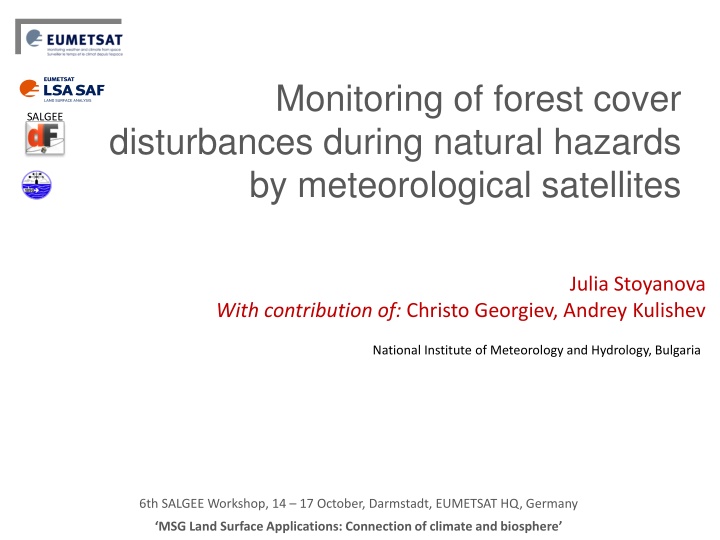

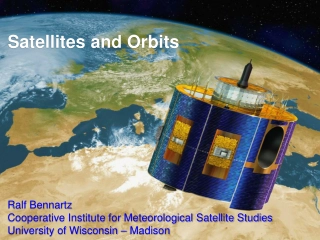
![[PDF⚡READ❤ONLINE] Neptune: The Planet, Rings, and Satellites](/thumb/21522/pdf-read-online-neptune-the-planet-rings-and-satellites.jpg)





